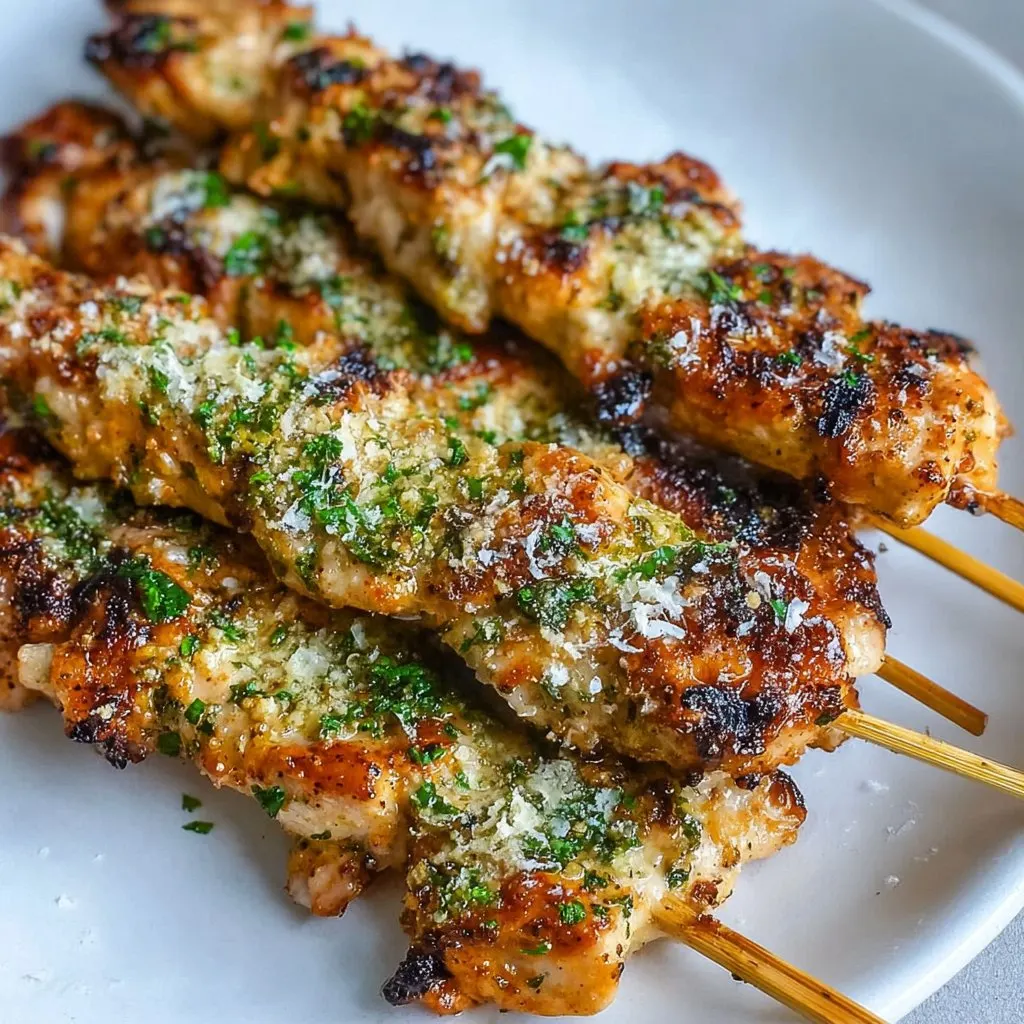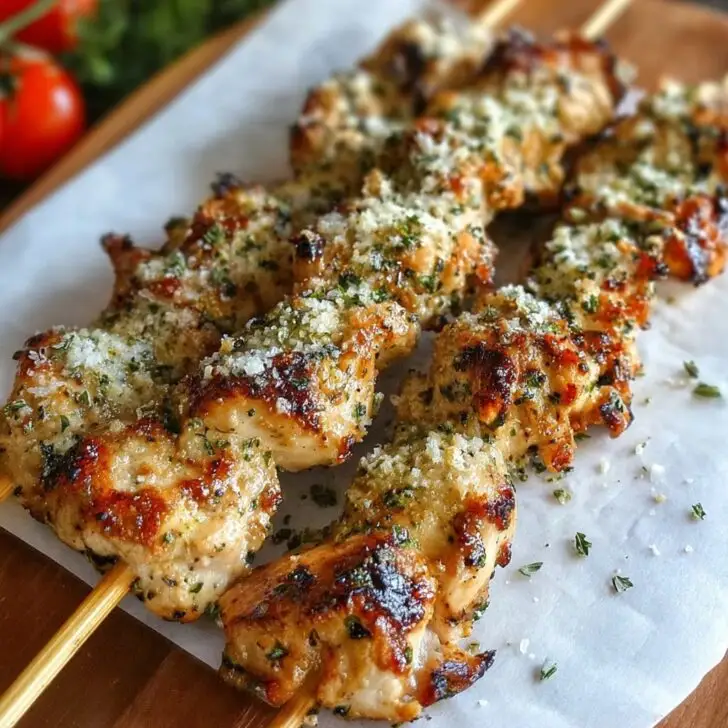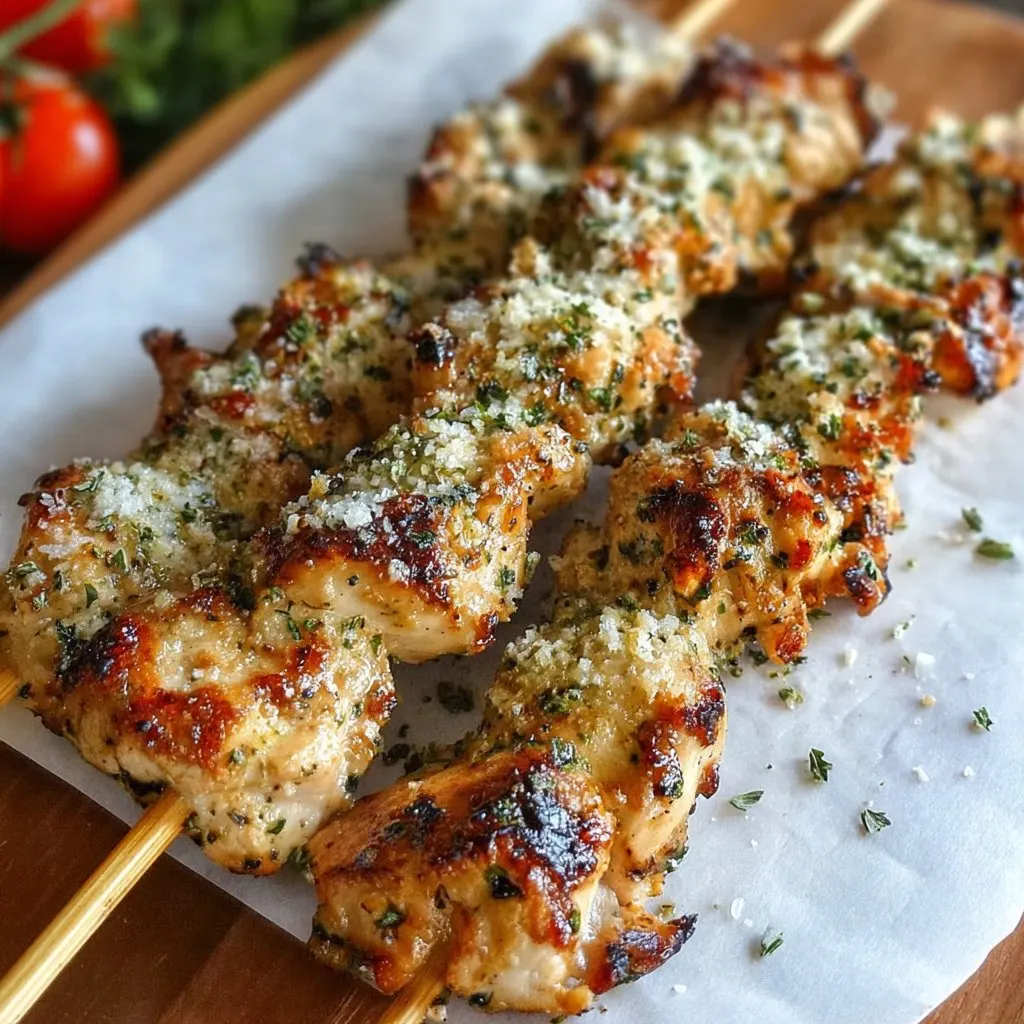The Story: My Ongoing Love Affair With Skewers
Alright, so you ever have one of those recipes that kind of sneaks its way into, well, every family barbecue, potluck, or even just Thursday night when you’re out of ideas? That’s what Ranch Garlic Parmesan Chicken Skewers are for me. The first time I made these, I was honestly just trying to use up a rogue packet of ranch mix and some half-forgotten Parmesan. My nephew called them “magic chicken sticks,” and honestly, that name stuck for a while (much to my embarrassment at a fancy-ish dinner). They’re messy, super flavorful, and make your kitchen smell like you actually know what you’re doing. Plus, you get to eat with your hands, which is always a win, right?
Why You’ll Love This (Or At Least Tolerate It!)
I mean, I make these whenever I want everyone to stop talking and start eating — which, if you’ve met my family, is a pretty regular goal. My mom gets weirdly competitive about who gets the last skewer (my advice: make extras, but hide a couple for yourself). These skewers are the dinnertime equivalent of a mic drop; crispy edges, garlicky ranch flavor, and melty little bits of cheese. Oh, and they’re great for when you can’t decide what to cook and just want something easy. The only hiccup I’ve had? Trying to grill them in a windstorm—do not recommend, unless you want your neighbors to question your life choices.
What You’ll Need (Plus a Few Swaps)
- Chicken breasts (about 1.5 lbs or 3 biggish ones). I’ve used thighs too; actually, I find it works better if you want juicier bites.
- Ranch seasoning (one packet or about 3 tablespoon if you’ve got the bulk stuff; honestly, I’ve used off-brand and can’t tell the difference)
- Grated Parmesan (the stuff in the green can is fine; if you’re feeling fancy, freshly grated is top notch)
- Fresh garlic (3 cloves, or a lazy spoon of pre-chopped from the jar—no judgment)
- Olive oil (about 3 tbsp, give or take)
- Salt & pepper (I skip the salt sometimes, especially if the ranch is salty)
- Optional: lemon juice (squeeze of half a lemon — my neighbor swears by it, but I forget half the time)
- Skewers (wood or metal; soak wood ones so they don’t turn into torches. Or just be quick about it, like I usually am.)
Let’s Get Cooking (Don’t Stress If It Gets Messy)
- Chop up your chicken into bite-sized pieces—think a bit bigger than a dice, but not too chunky. If you’re like me and your knife skills aren’t perfect, no worries, they cook quick anyway.
- In a big bowl, toss in the ranch seasoning, Parmesan (save a spoonful for later), garlic, olive oil, and a little pepper. Add the chicken pieces and give the whole thing a good mix. This is where I usually sneak a bite of raw chicken—JUST KIDDING, please don’t do that.
- If you can plan ahead, let the chicken marinate for 20-30 minutes (or while you tidy the kitchen or scroll Instagram).
- Thread the chicken pieces onto your skewers. Don’t pack them crazy tight; you want heat to get between the pieces.
- Preheat your grill, griddle, or oven broiler. Honestly, I’ve done this on a stovetop grill pan when it’s raining outside and it works fine (just open a window — the garlic gets intense).
- Grill or broil for about 10-12 minutes, flipping once. You’re looking for golden bits and slightly crispy cheese. If you have any Parmesan left, sprinkle it on in the last two minutes for a melty crust.
- Let them rest for a couple of minutes. They’ll be screaming hot, and I may have learned this the hard way.
Notes From My (Not Always Successful) Kitchen
- If you forget to soak wooden skewers, just keep an eye on them. Worst case, you’ll get a little smoky flavor; best case, nobody notices.
- I think these taste better the next day, probably because the flavors settle in somehow. Or maybe I’m just hungrier by then?
- Sometimes the Parmesan will burn a bit on the grill. That’s fine! Those burnt edges are little flavor bombs. Or that’s what I tell myself anyway.
Variations (And My One Fail, For Honesty’s Sake)
- Tried this with pork once—tasted decent, but not the same. Chicken’s still the winner in my book.
- If you’re out of Parmesan, a mix of Asiago and cheddar is okay. Or just use more ranch and less cheese; nobody’ll complain.
- For a spicy kick, throw in a pinch of chili flakes. My little brother will eat anything if it’s spicy, go figure.
Equipment: Don’t Panic If You Don’t Have It All
- Grill or broiler (or a stovetop grill pan—heck, I’ve even used the oven at 425F in a pinch)
- Mixing bowl (I just use the biggest one that’s clean, honestly)
- Skewers (If you don’t have any, just lay the marinated chicken out in a single layer on a baking sheet. Not technically a skewer dish, but who’s policing?)

Storing Leftovers (If You’re Lucky Enough To Have Any)
Pop leftovers in an airtight container and stick them in the fridge. They’re good for about 2 days, maybe 3 if you’re living on the edge. Honestly, in my house, these never last more than a day—my teenager once ate six skewers in one sitting, and I’m still a little impressed (and slightly horrified).
Serving It Up (Or How We Do It Round Here)
These skewers are perfect with a simple salad, or just some buttered corn on the cob if you’re keeping things classic. Sometimes I’ll pile them on top of garlic bread slices, which is a little over the top but oh-so-good. My aunt dips hers in extra ranch, which is a move I respect but cannot endorse for heart-health reasons.
Pro Tips (Learned The Hard Way!)
- Don’t rush the marinating—even 15 minutes makes a difference. I once skipped it, and the flavor was kind of flat. Lesson learned.
- Give the skewers a little space on the grill. If they’re crowded, they steam instead of char. Char is life.
FAQ: Real Questions I’ve Heard (And Answered)
- Can I use bottled ranch dressing instead of the dry mix?
- Honestly, I wouldn’t. It gets gloopy and weird (I tried it once—never again). Stick with the seasoning mix.
- What if I don’t have a grill?
- No stress! Oven broiler or a grill pan on the stove is fine. Even just baking at high heat works, but you might miss a bit of that smoky char. Actually, I find the broiler browns the cheese best.
- Are these gluten-free?
- Usually, but check your ranch mix just in case. Some brands sneak in weird stuff.
- Can I freeze them?
- Yep, though the texture’s a tad different when you reheat. But if you’re meal prepping, it works. I wrap them up and toss in the freezer for up to a month.
- Where do you get your ranch seasoning in bulk?
- Oh, I’m not fancy—I get mine here, or sometimes in the big canister at Costco. For fancier cheese, I love browsing Murray’s Cheese (dangerous for my wallet, though).
And if you’re still here, bless you! Let me know if you try these Ranch Garlic Parmesan Chicken Skewers—I’d love to hear if your family makes as big a mess as mine does. Cheers!
Ingredients
- 1.5 lbs boneless, skinless chicken breasts, cut into 1.5-inch cubes
- 2 tablespoons olive oil
- 2 tablespoons ranch seasoning mix
- 3 cloves garlic, minced
- ½ cup grated Parmesan cheese
- 1 teaspoon dried parsley
- ½ teaspoon black pepper
- ½ teaspoon salt
- Wooden or metal skewers
Instructions
-
1In a large bowl, combine olive oil, ranch seasoning mix, minced garlic, grated Parmesan cheese, dried parsley, black pepper, and salt.
-
2Add the chicken cubes to the bowl and toss until evenly coated. Cover and marinate in the refrigerator for at least 15 minutes.
-
3Preheat the grill to medium-high heat. If using wooden skewers, soak them in water for 20 minutes to prevent burning.
-
4Thread the marinated chicken pieces onto the skewers, leaving a little space between each piece.
-
5Grill the skewers for 7-9 minutes per side, or until the chicken is cooked through and has nice grill marks.
-
6Remove from the grill and let rest for 2 minutes before serving. Garnish with extra Parmesan and parsley if desired.
Approximate Information for One Serving
Nutrition Disclaimers
Number of total servings shown is approximate. Actual number of servings will depend on your preferred portion sizes.
Nutritional values shown are general guidelines and reflect information for 1 serving using the ingredients listed, not including any optional ingredients. Actual macros may vary slightly depending on specific brands and types of ingredients used.
To determine the weight of one serving, prepare the recipe as instructed. Weigh the finished recipe, then divide the weight of the finished recipe (not including the weight of the container the food is in) by the desired number of servings. Result will be the weight of one serving.
Did you make this recipe?
Please consider Pinning it!!


